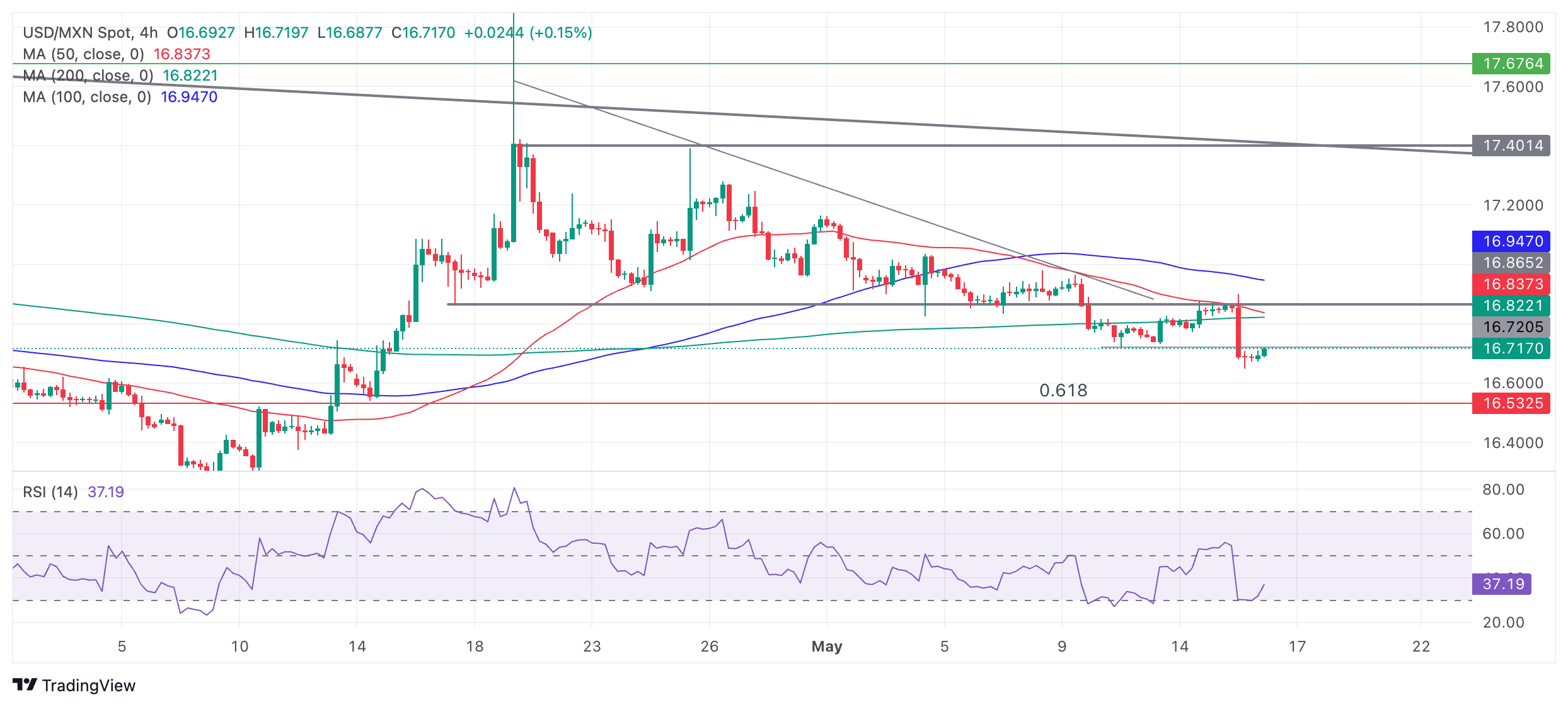- The Mexican Peso recovers against the US Dollar following key US data released on Wednesday.
- The CPI and US retail sales missed analyst expectations and showed a slowdown from previous readings.
- These data once again put on the table the possibility of an early cut in interest rates by the Fed, which weighs on the Dollar.
The Mexican Peso (MXN) is trading flat across most pairs on Thursday as traders pause following the currency's rally on Wednesday. Data on the Consumer Price Index (CPI) and retail sales for April in the United States, both below expectations, revealed a cooling in inflation and economic activity that recalibrated expectations about interest rates.
The data suggests that the Federal Reserve (Fed) may be more inclined to lower borrowing costs, which is negative for the US Dollar (USD) but overall positive for the Mexican Peso.
At the time of writing, USD/MXN is trading at four-week lows of 16.71, EUR/MXN at 18.18 and GBP/MXN at 21.19.
The Mexican peso falls after US data
The Mexican peso rebounded against the dollar, especially, but also against other major currencies, after the US CPI data failed to meet expectations, thus increasing the chances that the Fed will lower interest rates sooner than expected. Lower interest rates are negative for the dollar as they reduce foreign capital inflows.
The US headline CPI fell 0.3% monthly in April, below the 0.4% expected by experts and the 0.4% recorded in March, according to data from the US Bureau of Labor Statistics. The interannual rate stood at the estimated 3.4%, although below the 3.5% in March.
For its part, the CPI excluding food and energy stood at the expected monthly 0.3%, but also below the 0.4% in March. In annual terms, the indicator fell to the expected 3.6%, compared to the previous 3.8%.
US Retail Sales showed flat consumer spending, reading 0.0% in April, well below estimates of 0.4% and the month's downwardly revised 0.6% above, according to data from the US Census Bureau.
USD/MXN rose almost a percentage point on the news, as investors recalibrated their expectations about the future path of US interest rates.
Technical analysis: USD/MXN resumes bearish trend
The USD/MXN – the value of one US dollar in Mexican pesos – “said goodbye” to the key resistance level around 16.86, to which it had returned after its range break, and fell on Wednesday, recording significant losses in the Advance.
USD/MXN 4-hour chart

The pair has resumed its short-term bearish trend towards the conservative breakout target at 16.54, the 0.681 Fibonacci ratio of the range height extrapolated to the downside. The continuation of the downtrend could even reach 16.34, the full height of the extrapolated downward range.
Since the medium and long-term trends are bearish, the odds further favor the downside for the pair in line with those trends.
A recovery and decisive break within the range (above 16.86) would be necessary to reverse the downtrend.
A decisive breakout would be one accompanied by a longer than average Japanese candle that closed near its maximum or three consecutive green Japanese candles.
economic indicator
Consumer Price Index (monthly)
Inflationary or deflationary trends are measured by periodically adding the prices of a basket of representative goods and services and presenting the data as the Consumer Price Index (CPI). CPI data is collected monthly and published by the U.S. Bureau of Labor Statistics. The CPI is a key indicator for measuring inflation and changes in purchasing trends. Generally, a high reading is considered bullish for the US Dollar (USD), while a low reading is considered bearish.
Read more.
Last post: Wed May 15, 2024 12:30
Periodicity: Monthly
Current: 0.3
Consensus: 0 ,4
Former: 0 .4%
Fountain: US Bureau of Labor Statistics
The US Federal Reserve has the dual mandate of maintaining price stability and maximum employment. According to this mandate, inflation should be around 2% annually and has become the weakest pillar of the central bank's directive since the world suffered a pandemic, which continues to this day. Price pressures continue to mount amid supply chain issues and bottlenecks, with the Consumer Price Index (CPI) at multi-decade highs. The Fed has already taken steps to contain inflation and is expected to maintain an aggressive stance for the foreseeable future.
Source: Fx Street
I am Joshua Winder, a senior-level journalist and editor at World Stock Market. I specialize in covering news related to the stock market and economic trends. With more than 8 years of experience in this field, I have become an expert in financial reporting.







